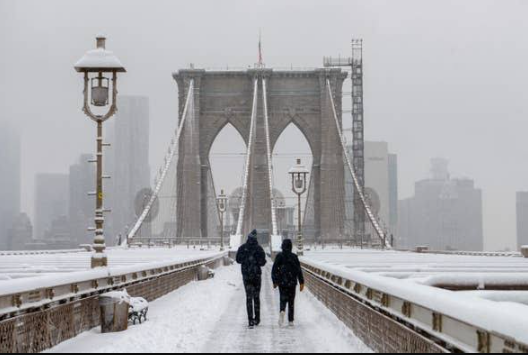Although parts of the United States have seen historic winter weather this season, other cities have been left wondering: where is the snow?
In Washington, D.C., residents of the nation’s capital haven’t seen measurable snow this winter. New York City also has yet to see its typical snow this season, in addition to Philadelphia and other parts of the Northeast.
“That whole corridor – New York, Philly, Baltimore, D.C. – they haven’t had any accumulating snow yet, which is highly unusual,” Tom Kines, senior meteorologist at AccuWeather, said. “And even up into Boston, even though it’s snowing up there (Monday), they haven’t had a whole lot of snow there either.”
“The whole I-95 corridor has been kind of in a snow drought this winter,” he said.
The average accumulation through about the third week in January for the Big Apple is 10.6 inches of snow, according to AccuWeather. Philadelphia sees an average of 7.8 inches, while Washington sees an average of 4.6 inches.
So far this winter, each city has seen only a trace of flakes.
But why haven’t these East Coast cities seen many snowflakes? Will the area see snow at all this winter? Here’s what you need to know.
Will New York, Washington see snow this week?
Kines said New York has the “best chance of a lot of those cities” of seeing accumulating snow into Wednesday.
“It looks like it’s going to be snow changing to rain in New York City. It’s just a matter of whether it’s 35 degrees and snowing or 31 and snowing. Obviously if it’s 35 and snowing, it’s not going to accumulate, where if it’s 31 it certainly will,” he said.
“A couple of degrees in temperature is going to make a big difference come Wednesday in New York whether they continue to keep that snow drought going.”
Meanwhile, Philadelphia could see rain and snow before noon on Wednesday, with snow and sleet accumulation of less than a half inch possible, according to the National Weather Service. And Washington and Baltimore, Maryland, on Wednesday are only expected to see rain.
What about later this winter and spring?
Kines said the tracks of several storms this winter haven’t hit the I-95 corridor.
“There’s been a lot of storms that have maybe gone through Texas and up through Tennessee and into western Pennsylvania. Those are the kind of tracks that keep the I-95 corridor in the mild weather. We haven’t seen anything unusual at least in the mid-Atlantic or northeast about the storm tracks,” he said.
He noted that AccuWeather is calling for above normal temperatures in February, with some potential “chilly weather returning in March.”
The Environmental Protection Agency also warns that total snowfall has decreased in some parts of the country over the last nearly 100 years, explaining that “In addition to changing the overall rate of precipitation, climate change can lead to changes in the type of precipitation.”
The EPA says the Pacific Northwest has seen a decline in total snowfall and the “proportion of precipitation falling as snow.” Some areas have seen increases, such as parts of the Great Lakes region.

